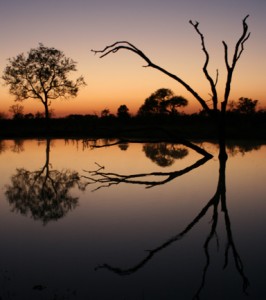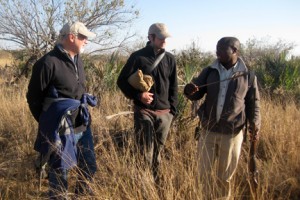Elephant range intro for Jason
I have been so fortunate to get an introduction to Botswana’s elephant range directly from Elephants Without Borders. Mike and Kelly have been great hosts and teachers throughout my time here. The glorious life of a graduate student, like myself, who studies elephant movement patterns and range expansion, is far too often characterized by late nights hunched over a computer. However, no amount of time spent with my computer could provide the real world understanding of Botswana’s landscape and elephant population gained through this very full and exciting field visit.
I travelled to Kasane, Botswana with my advisor, Dr. Curtice Griffin, who was also Mike’s PhD advisor. Shortly after arrival, we piled in the land rover for a game drive through the Chobe waterfront and finished the day with great conversation over delicious food prepared by Kelly. Over the next couple of days we were able to catch up and experience Kasane, where the human-wildlife interface is pervasive, inspiring, and complex. This is truly a special place, where wildlife still permeates the human matrix as animals travel back and forth between Chobe’s waterfront resources and important habitat situated on the opposite side of human settlement.
Next, we took the short trip from Kasane to the town of Victoria Falls, in Zimbabwe. We wanted to see how elephants were using the human matrix there as a somewhat parallel situation to Kasane. It was amazing to see how far into the town elephants were willing to go. While in town we also visited Victoria Falls, one of the wonders of the natural world. This had absolutely nothing to do with elephants, but was amazing and awe inspiring none-the-less.
Back in Kasane again, we had a chance to visit a couple recently constructed artificial water holes. One was very active the two evenings we visited. Multiple herds of elephants made use of this pan and seemed to drink directly from the source when possible. The water pumps are run via solar power which have various mechanisms to keep baboons from causing havoc on them. I was reminded of my neighbor’s never-ending battle to keep squirrels from emptying his back-yard bird feeder.
It was now time to head into the bush and experience more of the elephant range. We drove through The Enclave, another place where people share their living space with elephants. We came across what could have been an installation art exhibit hanging just outside a family’s fenced in home. Collections of salvaged metal hung from trees. A second rope, also attached to the metal, ran behind a fence. We chatted with the family who explained how they use this home-made noise maker designed in an effort to repel elephants.
We were now heading into the parts of the elephant range with less of a human footprint. We camped and explored near Savute marsh and eastern parts of Moremi Game Reserve. We were also fortunate to take a low level flight westward over the Selinda Spillway, all the way to the veterinary fence and then back to the Savute airstrip skirting the northern edge of the Okavango Delta. The aerial perspective was invaluable for gaining insight into the various habitat types and the distribution of seasonal pans. We also had a chance to check in on one of EWB’s collared elephants, Atticus, by tracking him from the air. When we found him, he was hanging out with three other bulls.
From the bush we headed to Maun. We had a morning flight out to The Delta. Even the flight in was amazing with an immediate sense for how complex the hydrological system is in this region. We saw abundant wildlife from over 2000 ft in the air so I can only imagine what we would have seen if we were flying lower.
What a wonderful introduction from northern Botswana! It has been truly helpful for me to understand the elephant range and beyond that…was just fun! Thanks Mike and Kelly.
Jason Estes is utilizing Elephants Without Borders 11 years of elephant movement data to complete his PhD, investigating the dynamics of elephant movements within, in and outside of Botswana to enhance our understanding of elephant range expansion, elephant movement corridors, factors affecting seasonal home-ranges, effects of fences, and fine-scale movements of elephants in human dominated areas.
Be sure to check updates on our website at http://www.elephantswithoutborders.org/
To support EWB’s projects http://www.elephantswithoutborders.org/donate.php
and follow us on Facebook https://www.facebook.com/elephantswithoutborders
Tags: botswana, chobe, conservation, elephants, elephants without borders, research, wildlife









